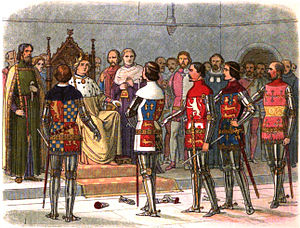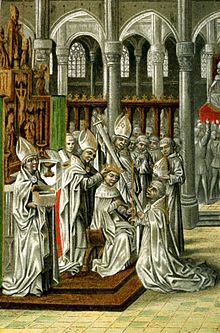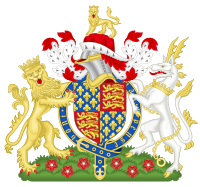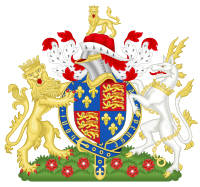
Henry IV of England
Background Information
This Wikipedia selection is available offline from SOS Children for distribution in the developing world. All children available for child sponsorship from SOS Children are looked after in a family home by the charity. Read more...
| Henry IV | |
|---|---|
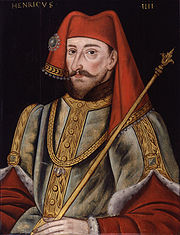 |
|
| 16th-century painting of Henry IV | |
|
|
|
| Reign | 30 September 1399 – 20 March 1413 |
| Coronation | 13 October 1399 |
| Predecessor | Richard II |
| Successor | Henry V |
| Spouse | Mary de Bohun Joan of Navarre |
| Issue | |
| Edward of Lancaster Henry V of England Thomas of Lancaster, 1st Duke of Clarence John of Lancaster, 1st Duke of Bedford Humphrey, 1st Duke of Gloucester Blanche, Electress Palatine Philippa, Queen of Denmark, Norway and Sweden |
|
| House | House of Lancaster |
| Father | John of Gaunt, 1st Duke of Lancaster |
| Mother | Blanche of Lancaster |
| Born | 15 April 1366 Bolingbroke Castle, Lincolnshire |
| Died | 20 March 1413 (aged 46) Westminster, London |
| Burial | Canterbury Cathedral, Kent |
| Signature |  |
Henry IV (15 April 1366 – 20 March 1413) was King of England and Lord of Ireland (1399–1413). He was the tenth King of England of the House of Plantagenet and also asserted his grandfather's claim to the title King of France. He was born at Bolingbroke Castle in Lincolnshire, hence his other name, Henry (of) Bolingbroke (pron.: / ˈ b ɒ l ɪ ŋ b r ʊ k /). His father, John of Gaunt, was the third son of Edward III, and enjoyed a position of considerable influence during much of the reign of Henry's cousin Richard II, whom Henry eventually deposed. Henry's mother was Blanche, heiress to the considerable Lancaster estates, thus he became the first King of England from the Lancaster branch of the Plantagenets.
Siblings
One of Henry's elder sisters, Philippa of Lancaster, married John I of Portugal, and the other, Elizabeth, was the mother of John Holland, 2nd Duke of Exeter. His younger half-sister Catherine, the daughter of his father's second wife, Constance of Castile, was queen consort of Castile. He also had four half-siblings by Katherine Swynford, originally his sisters' governess, then his father's longstanding mistress, and later his third wife. These four children were given the surname Beaufort after a castle their father held in Champagne, France.
Henry's relationship with his stepmother, Katherine Swynford, was a positive one, but his relationship with the Beauforts varied. In youth he seems to have been close to all of them, but rivalries with Henry and Thomas proved problematic after 1406. His brother-in-law Ralph Neville remained one of his strongest supporters, and so did his eldest half-brother John Beaufort, even though Henry revoked Richard II's grant to John of a marquessate. Thomas Swynford, a son from Katherine's first marriage to Sir Hugh Swynford, was another loyal companion. Thomas was Constable of Pontefract Castle, where King Richard II is said to have died.
Eventually, a direct descendant of John of Gaunt and Katherine Swynford through the Beaufort line would take the throne as Henry VII.
Relationship with Richard II
Henry experienced a rather more inconsistent relationship with King Richard II than his father had. First cousins and childhood playmates, they were admitted together to the Order of the Garter in 1377, but Henry participated in the Lords Appellant's rebellion against the king in 1387. After regaining power, Richard did not punish Henry, although he did execute or exile many of the other rebellious barons. In fact, Richard elevated Henry from Earl of Derby to Duke of Hereford.
Henry spent the full year of 1390 supporting the unsuccessful siege of Vilnius (capital of the Grand Duchy of Lithuania) by Teutonic Knights with his 300 fellow knights. During this campaign he bought 300 captured Lithuanian princes and then apparently took them back to England. Henry's second expedition to Lithuania in 1392 illustrates the financial benefits to the Order of these guest crusaders. His small army consisted of over 100 men, including longbow archers and six minstrels, at a total cost to the Lancastrian purse of £4,360. Despite the efforts of Henry and his English crusaders, two years of attacks on Vilnius proved fruitless. In 1392–93 Henry undertook a pilgrimage to Jerusalem, where he made offerings at the Holy Sepulchre and at the Mount of Olives. Later he vowed to lead a crusade to 'free Jerusalem from the infidel,' but he died before this could be accomplished.
The relationship between Henry Bolingbroke and the king met with a second crisis. In 1398, a remark by Bolingbroke regarding Richard II's rule was interpreted as treason by Thomas de Mowbray, 1st Duke of Norfolk. The two dukes agreed to undergo a duel of honour (called by Richard II) at Gosford Green near Caludon Castle, Mowbray's home in Coventry. Yet before the duel could take place, Richard II decided to banish Henry from the kingdom (with the approval of Henry's father, John of Gaunt) to avoid further bloodshed. Mowbray himself was exiled for life.
John of Gaunt died in 1399. Without explanation, Richard cancelled the legal documents that would have allowed Henry to inherit Gaunt's land automatically. Instead, Henry would be required to ask for the lands from Richard. After some hesitation, Henry met with the exiled Thomas Arundel, former Archbishop of Canterbury, who had lost his position because of his involvement with the Lords Appellant. Henry and Arundel returned to England while Richard was on a military campaign in Ireland. With Arundel as his advisor, Henry began a military campaign, confiscating land from those who opposed him and ordering his soldiers to destroy much of Cheshire. Henry quickly gained enough power and support to have himself declared King Henry IV, imprison King Richard (who died in prison under mysterious circumstances) and bypass Richard's seven-year-old heir-presumptive, Edmund de Mortimer. Henry's coronation, on 13 October 1399, marked the first time following the Norman Conquest when the monarch made an address in English.
Henry consulted with Parliament frequently, but was sometimes at odds with the members, especially over ecclesiastical matters. On Arundel's advice, Henry obtained from Parliament the enactment of De heretico comburendo in 1401, which prescribed the burning of heretics; this was done mainly to suppress the Lollard movement. In 1410, parliament suggested confiscating church land. Henry refused to attack the Church that had helped him to power, and the House of Commons had to beg for the bill to be struck off the record.
Reign
The previous ruler
Henry's first major problem as monarch was what to do with the deposed Richard. After an early assassination plot (The Epiphany Rising) was foiled in January 1400, Richard died in prison of starvation. He was thirty-three years old. Though Henry is often suspected of having his predecessor murdered, there is no substantial evidence to prove that claim. Some chroniclers claimed that the despondent Richard had starved himself, which would not have been out of place with what is known of Richard's character. Though council records indicate that provisions were made for the transportation of the deposed king's body as early as 17 February, there is no reason to believe that he did not die on 14 February, as several chronicles stated. It can be positively said that he did not suffer a violent death, for his skeleton, upon examination, bore no signs of violence; whether he did indeed starve himself or whether that starvation was forced upon him are matters for lively historical speculation. After his death, Richard's body was put on public display in the old St Paul's Cathedral to prove to his supporters that he was truly dead, though this did not stop rumours from circulating for years after that he was still alive and waiting to take back his throne. Henry had Richard discreetly buried in the Dominican Priory at King's Langley, Hertfordshire, where he remained until King Henry V brought his body back to London and buried him in the tomb that Richard had commissioned for himself in Westminster Abbey.
Rebellions
Henry spent much of his reign defending himself against plots, rebellions and assassination attempts.
| English Royalty |
| House of Lancaster |
|---|
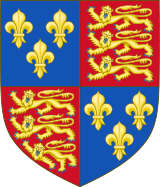 Armorial of Plantagenet
|
| Henry IV |
|
Rebellions continued throughout the first ten years of Henry's reign, including the revolt of Owain Glyndŵr, who declared himself Prince of Wales in 1400, and the rebellion of Henry Percy, 1st Earl of Northumberland. The king's success in putting down these rebellions was due partly to the military ability of his eldest son, Henry of Monmouth, who later became king (though the son managed to seize much effective power from his father in 1410).
In the last year of Henry's reign, the rebellions picked up speed. "The old fable of a living Richard was revived", notes one account, "and emissaries from Scotland traversed the villages of England, in the last year of Henry's reign, declaring that Richard was residing at the Scottish Court, awaiting only a signal from his friends to repair to London and recover his throne."
A suitable-looking impostor was found and King Richard's old groom circulated word in the city that his master was alive in Scotland. "Southwark was incited to insurrection" by Sir Elias Lyvet ( Levett) and his associate Thomas Clark, who promised Scottish aid to carry out the insurrection. Ultimately, the rebellion came to naught. The knight Lyvet was released and his follower thrown into the Tower.
List of rebellions
- Epiphany Rising (1400). Executions of the Earls of Kent, Huntingdon and Salisbury and the Baron le Despencer for their attempt to have Richard II restored as King.
- Glyndŵr Rising in Wales (1400–1415), led by Owain Glyndŵr.
- Percy Rebellion (1402–1408): three attempts by the Percy family and their allies to overthrow Henry:
- Battle of Shrewsbury (1403). King Henry IV defeated a rebel army led by Henry Hotspur Percy who had allied with the Welsh rebel Owain Glyndŵr. Percy was killed in the battle by an arrow in his face. Thomas Percy, 1st Earl of Worcester, Sir Richard Venables and Sir Richard Vernon were publicly hanged, drawn and quartered in Shrewsbury on 23 July and their heads publicly displayed. The Earl of Northumberland fled to Scotland.
- Archbishop of York Richard le Scrope led a failed rebellion in northern England (1405). Scrope and other rebel leaders were executed. The Earl of Northumberland again fled to Scotland.
- Battle of Bramham Moor (1408). The Earl of Northumberland invaded Northern England with Scottish and Northumbrian allies but was defeated and killed in battle.
Foreign relations
Early in his reign, Henry hosted the visit of Manuel II Palaiologos, the only Byzantine emperor ever to visit England, from December 1400 to January 1401 at Eltham Palace, with a joust being given in his honour. He also sent monetary support with him upon his departure to aid him against the Ottoman Empire.
In 1406 English pirates captured the future James I of Scotland off the coast of Flamborough Head as he was going to France. James was delivered to the English king and remained a prisoner for the rest of Henry's reign.
Final illness and death
The later years of Henry's reign were marked by serious health problems. He had a disfiguring skin disease and, more seriously, suffered acute attacks of some grave illness in June 1405; April 1406; June 1408; during the winter of 1408–09; December 1412; and finally a fatal bout in March 1413. Medical historians have long debated the nature of this affliction or afflictions. The skin disease might have been leprosy (which did not necessarily mean precisely the same thing in the 15th century as it does to modern medicine), perhaps psoriasis, or some other disease. The acute attacks have been given a wide range of explanations, from epilepsy to some form of cardiovascular disease. Some medieval writers felt that he was struck with leprosy as a punishment for his treatment of Richard le Scrope, Archbishop of York, who was executed in June 1405 on Henry's orders after a failed coup.
According to Holinshed, it was predicted that Henry would die in Jerusalem, and Shakespeare's play repeats this prophecy. Henry took this to mean that he would die on crusade. In reality, he died in the "Jerusalem" chamber of the house of the Abbot of Westminster, on 20 March 1413 during a convocation of Parliament. His executor, Thomas Langley, was at his side.
Burial
Despite the example set by most of his recent predecessors, Henry and his second wife, Joan of Navarre, Queen of England, were buried not at Westminster Abbey but at Canterbury Cathedral, on the north side of Trinity Chapel and directly adjacent to the shrine of St Thomas Becket. Becket's cult was then still thriving, as evidenced in the monastic accounts and in literary works such as Chaucer's 'Canterbury Tales', and Henry seemed particularly devoted to it, or at least keen to be associated with it. Reasons for his interment in Canterbury are debatable, but it is highly likely that Henry deliberately associated himself with the martyr saint for reasons of political expediency, namely, the legitimation of his dynasty after seizing the throne from Richard II. Significantly, at his coronation, he was anointed with holy oil that had reportedly been given to Becket by the Virgin Mary shortly before his death in 1170; this oil was placed inside a distinct eagle-shaped container of gold. According to one version of the tale, the oil had then passed to Henry's maternal grandfather, Henry of Grosmont, 1st Duke of Lancaster. Proof of Henry's deliberate connexion to St Thomas lies partially in the structure of the tomb itself. The wooden panel at the western end of his tomb bears a painting of the martyrdom of Becket, and the tester, or wooden canopy, above the tomb is painted with Henry's personal motto, 'Soverayne', alternated by crowned golden eagles. Likewise, the three large coats of arms that dominate the tester painting are surrounded by collars of SS, a golden eagle enclosed in each tiret. The presence of such eagle motifs points directly to Henry's coronation oil and his ideological association with St Thomas. Sometime after the King's death, an imposing tomb was built for him and his queen, most likely commissioned and paid for by Queen Joan herself. Atop the tomb chest lie detailed alabaster effigies of the King and Queen, crowned and dressed in their ceremonial robes. Henry's body was evidently well-embalmed, as an exhumation in 1832 established, allowing historians to state with reasonable certainty that the effigies do represent accurate portraiture.
Titles, styles, honours and arms
Titles
-
- Henry Bolingbroke
-
- Earl of Derby (by courtesy until his father's death)
- Earl of Northampton – restored 1384 to his father-in-law's earldom
- Duke of Hereford – after the punishment of the Lords Appellant
- 2nd Duke of Lancaster – upon his father's death
- King of England, Henry IV by deposition of his cousin King Richard II
Arms
Before his father's death in 1399, Henry bore the arms of the kingdom, differenced by a label of five points ermine. After his father's death, the difference changed to a label of five points per pale ermine and France. Upon his accession as king, Henry updated the arms of the kingdom to match an update in those of royal France – from a field of fleur-de-lys to just three.
|
Seniority in line from Edward III
When Richard II was forced to abdicate the throne in 1399, Henry was next in line to the throne according to Edward III's entailment of 1376; but the heir of the royal estate according to the common law was Edmund Mortimer, 5th Earl of March, who descended from the daughter of Edward III's second son, Lionel of Antwerp. Bolingbroke's father, John of Gaunt, was Edward's third son. The problem was solved by emphasising Henry's descent in a direct male line, whereas March's descent was through his grandmother. The official account of events claims that Richard voluntarily agreed to resign his crown to Henry on 29 September. The country had rallied behind Henry and supported his claim in parliament. However, the question of the succession never went away. The problem lay in the fact that Henry was only the most prominent male heir, not the most senior in terms of agnatic descent from Edward III. This made him heir to the throne according to Edward III's entail to the crown of 1376, but, as Dr. Ian Mortimer has recently pointed out in his biography of Henry IV, this had probably been supplanted by an entail of Richard II made in 1399 (see Ian Mortimer, The Fears of Henry IV, appendix two, pp. 366–9). Henry thus had to overcome the superior claim of the Mortimers in order to maintain his inheritance. This difficulty compounded when the Mortimer claim was merged with the Yorkist claim in the person of Richard Plantagenet, Duke of York. The Duke of York was the heir-general of Edward III, and the heir presumptive (due to agnatic descent) of Henry's grandson Henry VI (since Henry IV's other sons did not have male heirs, and the legitimated Beauforts were excluded from the throne). The House of Lancaster was finally deposed by Edward IV, son of Richard Plantagenet, Duke of York, during the Wars of the Roses.
The following are the senior descendants of Edward III. The descendants that were alive at the death of Richard II are in bold.
- Edward III of England (1312–1377)
-
- Edward, the Black Prince (1330–1376)
-
- Edward (1365–1372)
- Richard II of England (1367–1400)
-
- Lionel of Antwerp, 1st Duke of Clarence (1338–1368)
-
- Philippa of Clarence, 5th Countess of Ulster (1355–1382)
-
- Roger Mortimer, 4th Earl of March (1374–1398)
-
- Edmund Mortimer, 5th Earl of March (1391–1425)
- Roger Mortimer (died young c. 1411)
- Anne de Mortimer (1390–1411) (Anne was King Edward IV's grandmother.)
- Eleanor (d. 1418)
-
-
-
- Edmund Mortimer (1376–1409?)
- Lady Elizabeth de Mortimer (1370/1371–1417)
- Lady Philippa de Mortimer (1375–1401)
-
-
-
- John of Gaunt, 1st Duke of Lancaster (1340–1399)
-
- Henry IV of England (1367–1413)
-
- Edmund of Langley, 1st Duke of York (1341–1402)
-
- Edward, Duke of Aumerle, later declined to Earl of Rutland
- Richard of Conisburgh, 3rd Earl of Cambridge (c. 1375 – 1415. He married Anne de Mortimer, see above.)
-
- Thomas of Woodstock, 1st Duke of Gloucester
Ancestry
| Ancestors of Henry IV of England | ||||||||||||||||||||||||||||||||||||||||||||||||||||||||||||||||||||||||||||||||||||||||||||||||||||||||||||||||||||||||||||||||||||||||||||||||||||||||||||||||||||||||||||||||||||||||||||||||||||||||||||||||||||||||||||||||||||||||||||||||||||||||||||||||||||||||||||||||||||||||||||||||||||||||||||||||||||||||||||||||||||||||||||||||||||||||||||||||||||||||||||||||||||||||||||||||||||||||||||||||||||||||||||||||||||||||||||||||||||||||||||||||||||||||||||||||||||||||||||||||||||||||||||||||||||||||||||||||||||||||||||||||||||||||||||||||||
|---|---|---|---|---|---|---|---|---|---|---|---|---|---|---|---|---|---|---|---|---|---|---|---|---|---|---|---|---|---|---|---|---|---|---|---|---|---|---|---|---|---|---|---|---|---|---|---|---|---|---|---|---|---|---|---|---|---|---|---|---|---|---|---|---|---|---|---|---|---|---|---|---|---|---|---|---|---|---|---|---|---|---|---|---|---|---|---|---|---|---|---|---|---|---|---|---|---|---|---|---|---|---|---|---|---|---|---|---|---|---|---|---|---|---|---|---|---|---|---|---|---|---|---|---|---|---|---|---|---|---|---|---|---|---|---|---|---|---|---|---|---|---|---|---|---|---|---|---|---|---|---|---|---|---|---|---|---|---|---|---|---|---|---|---|---|---|---|---|---|---|---|---|---|---|---|---|---|---|---|---|---|---|---|---|---|---|---|---|---|---|---|---|---|---|---|---|---|---|---|---|---|---|---|---|---|---|---|---|---|---|---|---|---|---|---|---|---|---|---|---|---|---|---|---|---|---|---|---|---|---|---|---|---|---|---|---|---|---|---|---|---|---|---|---|---|---|---|---|---|---|---|---|---|---|---|---|---|---|---|---|---|---|---|---|---|---|---|---|---|---|---|---|---|---|---|---|---|---|---|---|---|---|---|---|---|---|---|---|---|---|---|---|---|---|---|---|---|---|---|---|---|---|---|---|---|---|---|---|---|---|---|---|---|---|---|---|---|---|---|---|---|---|---|---|---|---|---|---|---|---|---|---|---|---|---|---|---|---|---|---|---|---|---|---|---|---|---|---|---|---|---|---|---|---|---|---|---|---|---|---|---|---|---|---|---|---|---|---|---|---|---|---|---|---|---|---|---|---|---|---|---|---|---|---|---|---|---|---|---|---|---|---|---|---|---|---|---|---|---|---|---|---|---|---|---|---|---|---|---|---|---|---|---|---|---|---|---|---|---|---|---|---|---|---|---|---|---|---|---|---|---|---|---|---|---|---|---|---|---|---|---|---|---|---|---|---|---|---|---|---|---|---|---|---|---|---|---|---|---|---|---|---|---|---|---|---|---|---|---|---|---|---|---|---|---|---|---|---|---|---|---|---|---|---|---|---|---|---|---|---|---|---|---|---|---|---|---|---|---|---|---|---|---|---|---|---|---|---|---|---|---|---|---|---|---|---|---|---|---|---|---|---|---|---|---|---|---|---|---|---|---|---|---|---|---|---|---|---|---|---|---|---|---|---|---|---|
|
||||||||||||||||||||||||||||||||||||||||||||||||||||||||||||||||||||||||||||||||||||||||||||||||||||||||||||||||||||||||||||||||||||||||||||||||||||||||||||||||||||||||||||||||||||||||||||||||||||||||||||||||||||||||||||||||||||||||||||||||||||||||||||||||||||||||||||||||||||||||||||||||||||||||||||||||||||||||||||||||||||||||||||||||||||||||||||||||||||||||||||||||||||||||||||||||||||||||||||||||||||||||||||||||||||||||||||||||||||||||||||||||||||||||||||||||||||||||||||||||||||||||||||||||||||||||||||||||||||||||||||||||||||||||||||||||||
Marriage and issue
The date and venue of Henry's first marriage, to Mary de Bohun, are uncertain but her marriage licence, purchased by Henry's father, John of Gaunt, in June 1380 is retained at the National Archives. The accepted date of the ceremony is 5 February 1381, at Mary's family home of Rochford Hall, Essex. Alternately, the near-contemporary chronicler Jean Froissart reports a rumour that Mary's sister Eleanor de Bohun kidnapped Mary from Pleshey Castle and held her at Arundel Castle, where she was kept as a novice nun in order to keep her half of the de Bohun inheritance under Eleanor's control (and consequently under that of her husband, Thomas of Woodstock, 1st Duke of Gloucester). There Mary was persuaded to marry Henry. They had six children:
- Henry V of England (1386–1422)
- Thomas of Lancaster, 1st Duke of Clarence (1388–1421)
- John of Lancaster, 1st Duke of Bedford (1389–1435)
- Humphrey of Lancaster, 1st Duke of Gloucester (1390–1447)
- Blanche of England (1392–1409) married in 1402 Louis III, Elector Palatine
- Philippa of England (1394–1430) married in 1406 Eric of Pomerania, king of Denmark, Norway and Sweden.
Mary died in 1394, and on 7 February 1403 Henry married Joanna of Navarre, the daughter of Charles d'Évreux, King of Navarre, at Winchester. She was the widow of John V of Brittany, with whom she had had four daughters and four sons; she and Henry had only one son Edmund, called Labourde, who was born and died in 1401. That in 1399 Henry had four sons from his first marriage was undoubtedly a clinching factor in his acceptability for the throne. By contrast, Richard II had no children and Richard's heir-presumptive Edmund Mortimer was only seven years old. The only two of Henry's six children who produced children to survive to adulthood were Henry V and Humphrey, Duke of Gloucester. Henry IV's male Lancaster line ended in 1471 during the War of the Roses, between the Lancastrians and the Yorkists, with the deaths of his grandson Henry VI and Henry VI's son Edward, Prince of Wales. Henry IV's son, Humphrey, Duke of Gloucester's descendants include Elizabeth Bowes-Lyon, queen consort of George VI and mother of Elizabeth II, and the Queen's current daughters-in-law, Camilla, Duchess of Cornwall and Sophie, Countess of Wessex.
